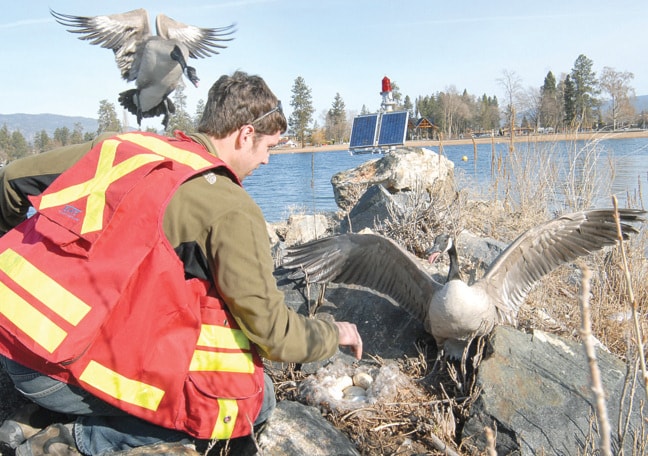The explosion of the Canada goose population in recent years has had a negative impact on everything from outdoor recreation to aircraft safety.
It is one of the main reasons why facilities like the Penticton Airport and others in the province have initiated management plans to keep the geese off their properties.
“Birds are a constant concern for aviation and we have a whole program in place called Bird Scare,” said Penticton Airport manager David Allen. “That includes when the tower tells us we have geese too close to where it’s safe. We go out there (in a vehicle) if we have to and run them off or we take out cracker shells (blanks fired from a gun) and scare them off.”
As part of reducing the population over time the Okanagan Valley Goose Management program is preparing for its fifth year of egg addling to control the number of Canada geese in public spaces.
Trained contractors have begun searching for nesting sites and hope to complete the addling program by the end of April.
“Last year, field crews located and addled 1,269 eggs between Vernon and Osoyoos,” said project co-ordinator Kate Hagmeier.
“The multi-year project aims to reduce the population of resident Canada geese to a more manageable level, and reduce large concentrations of geese in heavily used public areas.
“Due to the longevity of geese, it is expected to take three to five years to see a reduction in the Okanagan goose population from egg addling.”
Egg addling involves shaking eggs or coating them with non-toxic 100 per cent biodegradable food-grade corn oil within 14 days of incubation to make them non-viable.
The U.S. Humane Society considers egg addling during this time to be humane.
Once addled, the eggs are returned to the nest. Geese continue to incubate until they realize the eggs will not hatch. At this point, it is generally too late in the year to produce more eggs.
Adults are not harmed and will continue with their regular life cycle after the nesting season.
During the past four seasons, approximately 5,000 eggs have been prevented from hatching through this minimally invasive approach.
This program also entails a nest locating program and goose population surveys.
The public is asked to keep away from goose nests and to avoid touching the eggs; a special permit is required to perform egg addling.
An egg addling permit has been secured from the federal government, allowing crews from EBB Environmental Inc. and Wise Wildlife Control to addle goose eggs on public and private lands with the owner’s permission.
Public assistance is requested by reporting nest locations on private or public land. Email coordinator@okanagangooseplan.com or call 1-877-943-3209. Information about the program is available at okanagangooseplan.com.
Interior Health continues to encourage local governments throughout the Okanagan to reduce the risk of recreational water contamination from sources such as geese.
A swimming notification program was implemented by Interior Health in 2006. Since then, no beach advisories have had to be issued, due in part to the combination of activities to protect beaches and beach water areas.
